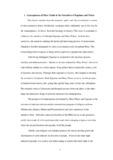Please use this identifier to cite or link to this item:
https://elibrary.tucl.edu.np/handle/123456789/3154Full metadata record
| DC Field | Value | Language |
|---|---|---|
| dc.contributor.author | Acharya, Jagadish | |
| dc.date.accessioned | 2021-04-02T05:09:47Z | |
| dc.date.accessioned | 2021-07-23T04:27:23Z | - |
| dc.date.available | 2021-04-02T05:09:47Z | |
| dc.date.available | 2021-07-23T04:27:23Z | - |
| dc.date.issued | 2015 | |
| dc.identifier.uri | http://elibrary.tucl.edu.np/handle/123456789/3154 | - |
| dc.description.abstract | This research is the study of two slave narratives by different writers from the perspective of romanticism. In the slave narratives, The History of Mary Prince, and The Interesting Narrative of the Life of Olaudh Equiano, the pervading romantic notion of individual freedom appears to be the sole and whole cause of the rise of abolitionist movement. In the popular romantic discourses, the orientation towards individual freedom and critique of social as well as institutional restriction are emphasized. The romanticists’ vision of individual freedom and social reform pave the way for the abolition of slavery, servitude and bondage of social restriction. In The History of Mary Prince, the narrator is steadily aware of the value and significance of liberty even in the condition of extreme misery. Right from her childhood, when she sees other people struggling for freedom from slavery, she grows acutely aware of liberty. The torture and punishment which she receives from her different slave holders implant in her a firm sense of freedom from slavery. She tries her level best to earn her freedom but none of her slaver holder allows her to buy her freedom. Her contact with various free women who go to church takes her from the bondage of slavery to the sunshine of freedom. It is in the church that she meets several free citizens who educate her about her value and necessity of freedom. After marrying a free black man she becomes hopeful that one day she will ultimately get freedom. When Prince surveys nature, and various creatures enjoying freedom, she asks herself why she cannot enjoy freedom like other creatures. The same is the condition of Equiano. Equiano moves from one place to the other in the course of following whosoever master buys him. He sees many black slaves buying their freedom with the money they saved by working overtime in the plantations of other workers. Equiano gets plenty of money through trade and commerce with which he gets freedom from the clutch of slavery. | en_US |
| dc.language.iso | en_US | en_US |
| dc.publisher | Central Department of English | en_US |
| dc.subject | English Literature | en_US |
| dc.subject | Slavery | en_US |
| dc.subject | History | en_US |
| dc.subject | Philosophy | en_US |
| dc.title | Slavery and Romantic Imagination in The History of Mary Prince and The Interesting Narrative of The Life of Olaudh Equiano | en_US |
| dc.type | Thesis | en_US |
| Appears in Collections: | English | |
Files in This Item:
| File | Description | Size | Format | |
|---|---|---|---|---|
| Cover Page-7.pdf | 207 kB | Adobe PDF |  View/Open | |
| Chapter Page-7.pdf | 617.07 kB | Adobe PDF |  View/Open |
Items in DSpace are protected by copyright, with all rights reserved, unless otherwise indicated.
